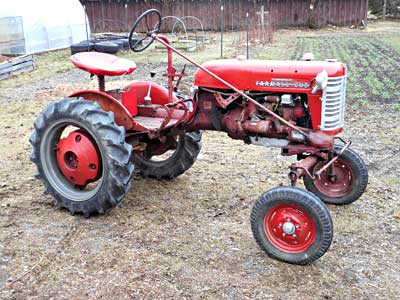 |
|
A 1955 Farmall Cub. Photo by Ben Hoffman |
By Ben Hoffman
To me, the most versatile, useful, practical farm machine ever made was the Farmall Cub. Introduced in 1947 to replace horses and mules on small farms, about 245,000 Cubs were produced from 1947 until 1979. The tractor featured a 4-cylinder, 9.25 horsepower gasoline engine, gradually increased to about 15 horsepower. A nice feature of the tractor was “cultivision,” offsetting the engine to the left so that the operator could look right down the row being worked.
The Cub was easily adaptable to horse-drawn implements, but McCormick-Deering and its successor, International Harvester, produced many implements, including plows, harrows, cultivators, planters, grader blades and sickle-bar mowers that mounted directly on the tractor, plus rakes, wagons, manure spreaders and other Cub-sized, towed implements. Several other manufacturers offered rotary and flail mowers, loaders and other attachments. Early Cubs had hand controls to raise and lower implements, but later models had hydraulics. One plus is the down pressure of Cub hydraulics, which most three-point hitches don’t offer.
In my mid-70s, being old and fragile, not young and agile, I had problems working my old Gravely walk-behind; it was just too much to handle. I looked around and finally found a 1972 Cub that ran well but needed some TLC (and paint). A year of chasing Uncle Henry’s ads produced most of the attachments I needed – disc harrow, plows, cultivators, mower, manure spreader. I even used the Cub for logging in snow, with a portable, Honda-powered winch and a wood trailer or log sulky.
The Cub had two problems – height and difficulty swapping implements. Regarding height, the Cub is high enough off the ground to till corn up to 2 feet tall – too tall for me to stay on the tractor safely.
Regarding implements, I used the mower and cultivators most, and both are very heavy and must be changed frequently in spring and early summer. Unlike changing three-point implements, the 45-minute on-off process was tedious.
After slipping off my Cub several times, I shopped for a lower machine, ending up with an elderly, 18 horsepower John Deere with four-wheel drive and a bucket loader, something I should have done years before. One bucket equals six wheelbarrows. And the John Deere handles a 4-foot rototiller, grader blade, flail mower, logging winch and three-point-hitch grain drill.
To help pay for my new acquisition, I sold the Cub and its implements, but I missed the Cub cultivators and sickle bar. The fairly rigid 5-foot mower, mounted midships where you could easily see what you were doing, was ideal for mowing lodged grain. After three years, unable to find a reasonably priced mower for the John Deere, I bought another Cub – a 1970 model with a new radiator, excellent rubber and necessary implements, plus a grader blade that mounts midships for shaping roads or terraces or up front for plowing snow. The disc hillers also work well for terracing, turned out to form a groove rather than in, to hill.
A year later, having 3 acres (and some adjoining land that I work) and only two tractors, I bought another Cub. It cost less than a riding lawn mower at Home Depot and is old enough to collect social security this year. That solved the problem of swapping implements – one Cub has the mower, the other has cultivators.
To minimize soil disturbance, I played around with strip (zone) tillage, first with a Mantis tiller with one gang removed, then with the Cub disc hillers. By sowing Dutch white clover with the grain, I can strip till through the clover the year after grain harvest to plant beans and potatoes. Using a one-row planter mounted behind the Cub, I can till the strip and plant in one pass, thus minimizing compaction. With rows spaced 3 feet apart, cultivision makes hilling beans and spuds easy, and a rotary lawn mower controls clover between rows.
I may pick up a couple of used mowers and mount them on the rear cultivator bars to hill and mow in one pass. I will likely switch to a longer rotation, maintaining the clover as long as possible as a living mulch, nitrogen fixer and ground cover. For example:
Year 1 – Sow grain and undersow with clover; harvest grain and leave clover.
Year 2 – Strip till clover and plant dry beans in strips.
Year 3 – Plant corn between rows where beans were (to get some nitrogen from the beans).
Year 4 – Plant potatoes in strips where beans were. Sow winter grain after potato harvest and reseed clover in mid-September or frost seed in spring – or till the ground after potato harvest and seed spring grain and clover in April.
That way I will disturb only a narrow crop row for three years and will have a four-year rotation with minimal soil disturbance.
Cub owners almost form a cult. You can connect with them online by putting “Farmall Cub” in your search engine. Many YouTube videos show Cubs and implements at work and photos of specialized implements made by Cub owners. Used Cubs range in price from $1,500 to $5,000, depending on condition. For the small-acreage grower, they are great tools, and with small tractors now priced over $10,000, consider rebuilding an elderly Cub. You can’t go wrong.
About the author: Ben Hoffman has degrees in forestry and has worked for the U.S. Forest Service, the Vermont Forest Service, Weyerhaeuser and the University of Maine. He has also taught forestry in British Columbia and Alaska. He returned to Maine in 2001 to dabble in consulting and writing and to play with trains.
